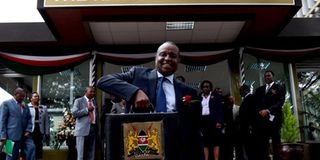Four years down the line, it is hard to state real cost of implementing the Constitution

National Treasury Cabinet Secretary Henry Rotich outside the Treasury building in Nairobi on June 12, 2014. FILE PHOTO | SALATON NJAU |
What you need to know:
- Belief: The jury is still out on whether the document represents value for money but the feeling that it is becoming expensive to implement is growing.
- The latest budget read by Cabinet Secretary Henry Rotich in June 2014 stood at 1.6 trillion.
The US Republicans and Democrats fundamentally differ on the size of government aside from issues like abortion, gay rights, gun control and immigration.
The Republicans tend to advocate a smaller government while Democrats are seen to favour a big government.
Kenya may be facing a similar situation.
Even before the 2010 Constitution was promulgated on August 27, there was debate on cost but some groups gave assurances that there should be no worry about the cost of implementing it.
“Critics of the draft Constitution are basing their objection on the fallacious assumption that cheaper is better; that we should not adopt the draft Constitution as it will be more expensive than the current one,” the International Commission of Jurists – Kenya wrote.
The civil society group added: “In reality, however, better is often more expensive, German cars cost more than Japanese ones for the simple reason that they are better.”
Four years down the line, it is still hard to quantify exactly what the cost of implementing this Constitution has been to the economy.
REMAINS BIG
The jury is still out on whether the document represents value for money, but the feeling that it is becoming expensive to implement is growing.
This is particularly so because while the 2010 Constitution has vastly expanded government at national and county levels, the central government remains as big, if not bigger, than it was under the old Constitution.
In June 2010, before the new Constitution was promulgated, the national budget stood at Sh916 billion.
The latest budget read by Cabinet Secretary Henry Rotich in June 2014 stood at 1.6 trillion.
Common understanding was that with the new dispensation, the devolution of functions and funds to the counties would in turn see a reduction in the size of the national government to reflect its reduced roles and responsibilities over the citizenry.
In 2011, the year following the coming into force of the Constitution, the national budget rose to Sh1.1 trillion, a 20 per cent jump from the previous year’s Sh916bn.
The national economy on the other hand expanded by just 5.6 per cent while revenues generated from taxes and other government services and investments rose by 17 per cent.
That budget, dubbed “Overcoming today’s challenges for a better tomorrow”, was read by then Finance Minister Uhuru Kenyatta, the current President.
To that end, Sh21 billion was allocated to fund Constitutional offices.
The Judiciary was allocated Sh9.3bn for its expansion and Parliament received Sh8.3 billion for both expansion and drafting of new laws.
RISING WAGES
However, the budget speech warned about the rising public wages.
At that time, the civil service exclusive of the military and the national intelligence stood at Sh226bn.
The following year, June 2012, the budget was read by Finance Minister Robinson Githae. Dubbed “Deepening our economic and social prosperity within a system of devolved government,” it represented a unique challenge.
The General Election was slated for December the same year after which county governments would come into being.
The Constitution provides for budget-making to be done at both national and county levels.
So this budget had to allocate resources to be used for the first six months under the old system through ministerial allocations and also plan for a scenario where many of those ministerial functions would be devolved for the second part of the financial year.
At Sh1.26 trillion, it represented a 14 per cent increase over the previous year’s budget. Significant, however, was the 112 per cent increase in the allocation of funds to Parliament whose budget rose from Sh8.1bn to Sh17bn.
This was ostensibly to provide for expansion of facilities including the setting up of the bicameral legislature to include a national assembly of MPs and a Senate.
Devolved functions that counties were expected to take over after the elections were allocated Sh148 billion while allocation to Constitutional offices rose by 100 per cent to Sh3bn.




